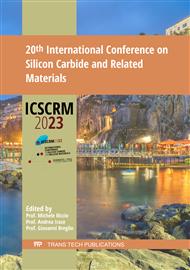p.1
p.7
p.13
p.19
p.27
p.33
p.41
p.47
Polarity Effect on the Heteroepitaxial Growth of BxC on 4H-SiC by CVD
Abstract:
The chemical vapor deposition (CVD) growth of boron carbide (BxC) layers on 4H-SiC, 4°off substrates was studied. Depending on the polarity of the substrate, different results were obtained. On Si face, the direct CVD growth at 1600°C under a mixture of BCl3+C3H8 systematically led to polycrystalline BxC films, whatever the C/B ratio in the gas phase. On the C face, heteroepitaxial growth was obtained for C/B ratios = 12 or higher with a step bunched morphology. If a boridation step (10 min at 1200°C under BCl3 flow) was used before the CVD growth, then heteroepitaxy was successful on both substrate polarities. To explain these results, a mechanism is proposed which involves the nature of the chemical bonds at the early stage of nucleation. It is suggested that a full B coverage of the SiC surface should favor the nucleation of the B-rich (0001) plane of BxC, promoting thus the heteroepitaxial growth along this direction.
Info:
Periodical:
Pages:
1-6
Citation:
Online since:
August 2024
Authors:
Keywords:
Permissions:
Share:
Citation:



